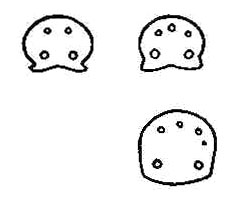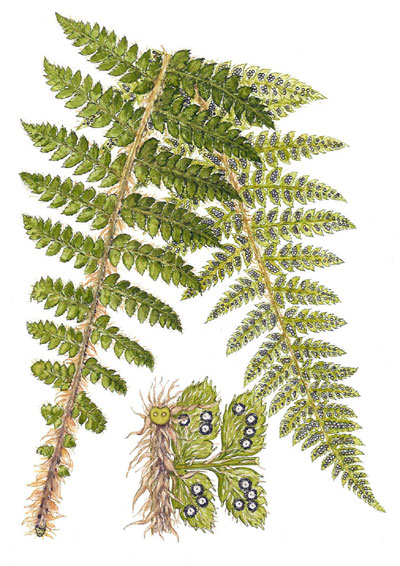| Polystichum braunii | ||
Braun's hollyfern, Prickly shield fern | ||
|
Etymology
Alexander Carl Heinrich Braun, 1805-1877, German professor of botany.
Description
Rhizome: short, stout, erect, very scaly.
Frond: 70 cm high by 22 cm wide, evergreen, monomorphic, blade/stipe ratio: 4: 1 to 6:1. Stipe: grooved, scales silvery at first, then light brown, dense at base, vascular bundles: 5-7, in an arc. Blade: 2-pinnate, ovate, broadest at the middle, tapered gradually to the base, the lowest pinnae only 2 cm long, dull, dark green, leathery, rachis scales linear, straw-colored, lamina with whitish to brown narrow scales on both sides. Pinnae: 20 to 40 pair, oblong; pinnules short-stalked, eared near the rachis, adnate further out, the first upper pinnule the same size or only slightly larger than the next ; margins edges toothed, with slender spiny tips; veins free, forked, anadromic. Sori: round, distinct and separate, in 1 row between midrib and margin, sparse, indusium: peltate, light brown, shriveling in maturity, central, sporangia: gray-brown to black, maturity: midsummer to later. Culture
Habitat: cool, moist, shaded places in boreal forests and northern deciduous woods; also rocky slopes and moist cliffs.
Distribution: North America, Europe, Asia.
Hardy to -35�C, USDA Zone 3.
Distinctive Characteristics
Similar in many respects to P. aculeatum, but the very small pinnae at the base are distinctive. This is also a larger plant with more fronds, a softer, duller lamina
Synonyms
Aspidium braunii Spenner Polystichum braunii subsp. purshii (Fernald) Calder & Roy L. Taylor Polystichum braunii var. purshii Fernald Dryopteris braunii (Spenner) Underwood |
|
|

Polystichum braunii. Vascular bundles at base of stipe (below) and fewer at the top of the stipe. An example with 7 bundles at the base�would be no surprise. �Drawing from Ferns of Northeastern United States, Farida A. Wiley, 1936. |

Polystichum braunii. a) frond, b) portion of fertile pinna, c) sorus. �Illustration by V. Fulford from Ferns and Fern Allies of Canada, William J. Cody and Donald M. Britton, 1989, � Agriculture Canada, used with permission. |

Polystichum braunii. Habit; stipe scales. Note tasseling during unfurling, typical of Polystichum. �Illustration from Scandinavian Ferns by Benjamin �llgaard and Kirsten Tind, Rhodos, 1993. |
